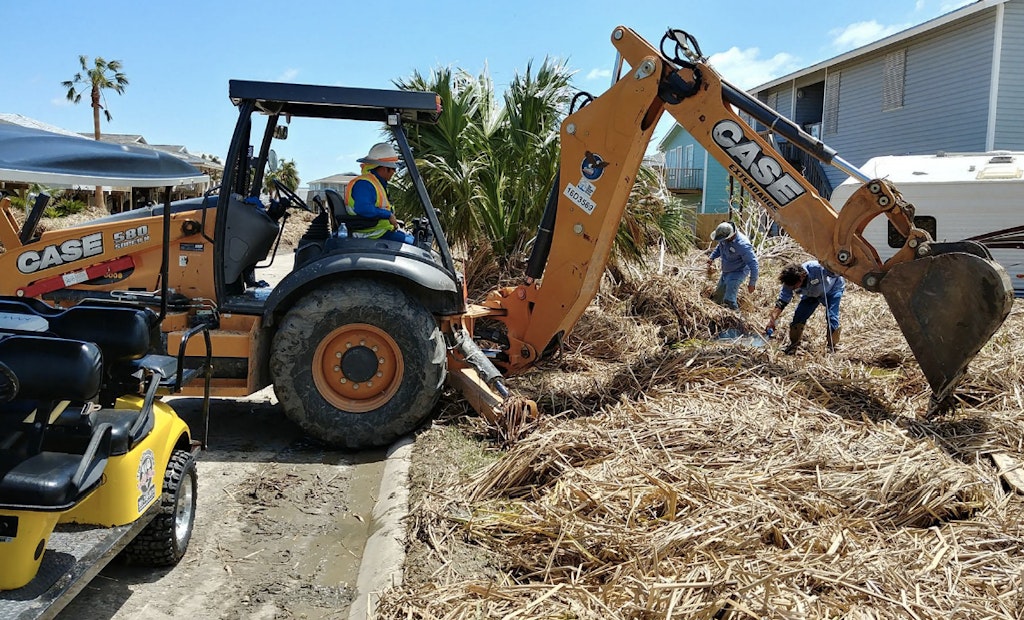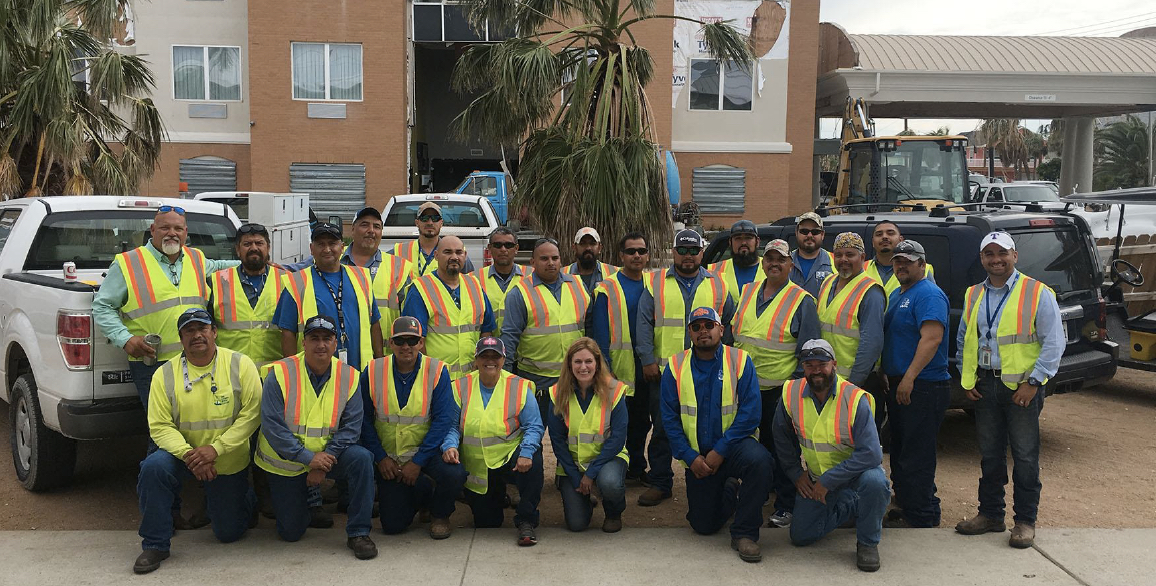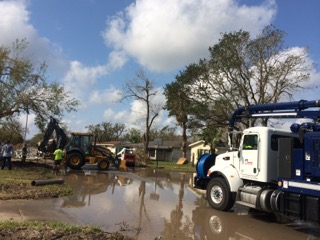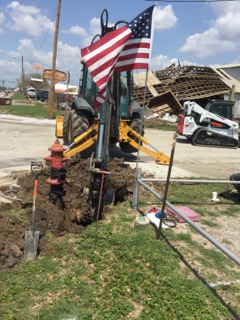
Interested in Education/Training?
Get Education/Training articles, news and videos right in your inbox! Sign up now.
Education/Training + Get AlertsCrew members from the San Antonio Water System (SAWS) received a call at 2 p.m. Sunday, Aug. 27, a matter of hours after Hurricane Harvey ravaged the Texas coastline. By 6:30 p.m., they were on the road to Port Aransas, carrying enough food to last several days, with no shelter waiting for them.
When they arrived in Port Aransas around 11:30 p.m., the 22 SAWS volunteers slept in their trucks. The next morning, the group showed up at the Port Aransas utility director’s door.
“He knew somebody was coming but had no idea there would be a small army at his front door at 7:30,” says Mike Howe, executive director of the Texas Section of the American Water Works Association. AWWA manages the Texas Water/Wastewater Agency Response Network, or TXWARN, as well as the WARN networks that now exist in every U.S. state.
The response network was created after Hurricane Katrina in 2005 — nationwide, utilities and AWWA realized they needed a more organized reaction to the next natural disaster. They coordinate resources for local utilities, working with federal and state organizations. In Texas, that includes the Trinity River Authority (TRA) and Texas Public Works Response Team (PWRT), which combined efforts to direct the city of Denton’s disaster relief efforts near Houston following Hurricane Harvey.
“It’s like a diesel engine, it’s always running. … It kind of runs in the background, and when there’s a disaster we’re able to put our foot on the throttle and shift into high gear,” Howe says. “We definitely saw, compared to Hurricane Ike (in 2008), with Hurricane Harvey, a much more coordinated response, at all levels, to the state and federal level, and with the utility responders.
“I think the cooperation and the ability to move resources in less than 24 hours was significant, and it was nice to see that all the planning worked real well.”
Helping a Neighbor
After Hurricane Harvey’s landfall, over the next 2 1/2 weeks, more than 90 SAWS employees, coordinated by TXWARN, made their way to Port Aransas and Rockport, offering whatever assistance they could.
“It was quite an experience going down there. They’re our neighbors, so we were eager to go help. It was kind of an honor for everybody to have the opportunity to go down there,” says Gordon Mahan, director of distribution and collections with SAWS, who was one of the first volunteers to make the trip.

Some of the SAWS employees who made the trip to Port Aransas and Rockport to provide assistance to their fellow utility workers.
Texas’ coastal cities experienced flooding and wind damage from the storm, which was rated as a Category 4 hurricane when it hit Port Aransas. Nearby Victoria received 15 1/2 inches of rain, which was relatively little compared to the 31 inches in Houston and 23 inches in the Galveston area, according to news reports.
“You could tell they were struggling,” Mahan says. “Their houses were damaged and destroyed, so they had to struggle with their own personal tragedies, and they were still there working to help get the water back on for everybody. It was quite a humbling experience for all of us.”
Port Aransas is part of an island strip near Corpus Christi, and is a popular place to visit among SAWS employees.
“Many of us go down there on vacation, or go down there fishing; we kind of know the area,” Mahan says. “At first it just didn’t look like the same place.”
Utility poles were down in every direction, area landmarks had been virtually erased, and Main Street was destroyed after 130 mph winds racked the city. The SAWS crews worked on shutting off connections to assess damage, and then used their own pumps and generators to pressurize the system until power returned.
From Repairing Water Mains to Prepping Treatment Plants
“These people have experienced a catastrophic event,” says Drew Huffman, manager of the city of Denton’s wastewater department. A crew from Denton also volunteered several days of their time to assist storm-devastated towns near the coast.
“Not only have they experienced this natural disaster, but they live there, they have an emotional connection there,” Huffman says. “They’d worked 16 hours a day for the past week before we got there, so we came in and that gave them the ability to take care of their homes and take care of their families.”
The Denton volunteers traveled to Refugio, Lake Jackson and Brazoria, repairing and cleaning water mains, and preparing plants and stations for when the power came back on. Because this area is south of Houston, it receives a lot of secondhand flooding from the urban metro area — much more than Port Aransas.
Refugio experienced pressure surges so severe they blew several water mains. The older town has infrastructure that couldn’t handle the additional stormwater. The volunteers fixed what they could of the blown water mains, and even installed a new hydrant to replace one that wouldn’t shut off.
In Lake Jackson, the group repaired a 12-inch collapsed drainline, got several lift stations back online, and sandbagged manholes to keep stormwater from infiltrating. During the storm I&I was a big issue, bringing with it debris that caused many blockages, which they helped clean.
TXWARN didn’t connect with Denton directly, but when they received a request from PWRT, they contacted TRA and put the two groups together. Out of that came Denton’s volunteer crew.
“When we got [to Brazoria], the sewer plant was above water, but the front gate of the sewer plant was 7 feet underwater,” Huffman says. And that was after the floodwaters had begun to recede.
Huffman and his volunteers pumped residual floodwater out of the plant’s headworks, then drained and cleaned the pumps, and fixed control panels that had been in contact with water. Overall, southern Texas was hit with 52 inches of rain, a continental record, and just an inch shy of the U.S. record, set in Hawaii. That’s the equivalent of 19 trillion gallons of rain throughout the life of the storm.
Sun-Up to Sundown
It wasn’t only water operators and utility crew members who volunteered. SAWS sent electricians and IT personnel later on to help get control systems up and running. Custodial staff even traveled down to look after the volunteers, who were working sun-up to sundown.
“The folks that went out there literally worked from when the sun came up till the sun went down, and they were all over the place. And so that was kind of something our folks took pride in, in that by the time they’d left … they were able to get the system up and going,” says Gavino Ramos, VP of communications and external affairs for SAWS. “It was a welcome relief — if you can imagine, those folks that lived on the island, their homes are devastated, and so we allowed them to take care of their personal needs while we went out to do the rest.”
By the time the SAWS crews left to return to San Antonio, electricity had returned and the water system was fully functional — thanks to their unwavering support.
“Everybody’s kind of running on adrenaline there a little bit. One of my struggles was trying to get the guys to stop working. To take their breaks, get something to eat, drink water,” Mahan says. “They were just eager to help out.”





